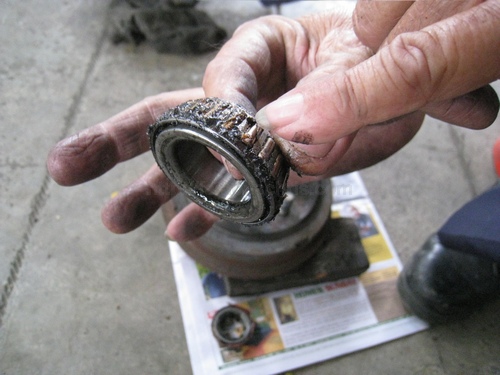To change a tyre 
To change a tyre is something most people are not keen on. Here we try to make it easy and as interesting for you. So that the next time you are involved in this fix, you will be out of it in a jiffy.
Before you begin, make sure that
The jack in your car is there
There is a properly inflated spare tyre
You have a lug wrench that fits your wheel
Lug bolts
Down to the basics
After you have parked your car safely, put a couple of bricks or stones beneath the tyres to make sure that it does not roll down. Bring your jack, spare wheel and lug wrench to the work area. Loosen the nuts without having jacked up the car, to prevent the wheel spin on you. Turn counterclockwise to loosen the nut until it comes off. Next jack up the car. Remove the old wheel now. After having taken out the lug nuts, pull the wheel with your weight forward to prevent from falling backward. Adjust well the spare wheel in the threaded shafts so that they fit. Then tighten the nuts in the proper order. Lower the jack so that the tyre rests on the ground. Replace the hubcap or the plate.
 Tyres
Tyres
Your tyres are what sits between you and the road.
Looking after your tyres will not only save you money - on tyres and also on fuel - but they are an essential safety feature of your car. Tyre replacements can often be unexpected and expensive so it makes sense to take care of them.
Taking care of your tyres
Keep your tyres inflated correctly. Inflate tyres to your manufacturers recommendations and recheck once a month. The recommended tyre pressure is usually recorded on the pillar of the driver’s door. Under inflated tyres result in increased road friction, meaning that the tyres will wear faster and require move fuel to run the car.
All four tyres should be of the same tread pattern. Ideally, the spare tyre should be identical. If fitting new tyres, put them on the same axle - preferably the rear. Regularly check the tread depth and tyre pressures (including the spare).
Match your tyres
Driving with mismatched tyres is dangerous. Among other warrant of fitness requirements, tyres on the same axle must be of the same tread pattern. However, there is no legal requirement for tyres on all axles to be the same tread, even though NZTA agrees that fitting four identical tyres (preferably summer) provides the best grip.
Snow tyres are made with a softer rubber compound and deeper treads, designed to maintain grip in ice and snow. They can be distinguished by their deep square-patterned tread blocks with numerous fine blades. Newer snow tyres are also marked with a 'mountain snowflake' symbol on the sidewall. They might be found on used cars imported from colder parts of Japan. In Japan, such tyres must have at least 50% tread depth to be legal, yet many below this will still comply with NZ's minimum tread depth of 1.5mm and thus can be used here.

Wheel balance
Tire balance, also referred to as tire unbalance or imbalance, describes the distribution of mass within an automobile tire or the entire wheel to which it is attached.
When the wheel rotates, asymmetries of mass may cause it to hop or wobble, which can cause ride disturbances, usually vertical and lateral vibrations. It can also result in a wobbling of the steering wheel or of the entire vehicle. The ride disturbance, due to unbalance, usually increases with speed. Vehicle suspensions can become excited by unbalance forces when the speed of the wheel reaches a point that its rotating frequency equals the suspension’s resonant frequency.

Firstly lets explain exactly what wheel balancing is and isn’t and then how much you should be expecting to pay for it.
Wheel balance is the art of measuring a wheel and tyre assemblys heavy spot and counter acting them with small lead weights.
If your wheels/tyres are out of balance you will likely get a vibration at speed ( 80km + ). The steering wheel may shake if its a front tyre, the whole car normally shakes if it is a rear tyre. A good tyre fitter will ask you what your symptoms are before ripping in and just balancing your wheels.
Wheels are balanced when new tyres are fitted, the wheel is spun up on a wheel balancing machine and the tyre fitter then bangs on small lead weights and then rechecks, until it spins up perfectly.
Things to watch out for..
Too much weight – a good tyre would normally only need a smallish weight, if the fitter is attaching enough weights to sink a small boat, it would be a good idea to ask why!
Weights should be all in one place on each side of the wheel. i.e you would not have weights opposite each other as that is counter productive.
If you get a shake or wobble at slow speeds, you may have a buckled rim or out of round tyre. Occasionally the tyre may even be seperating which is where the tread and casing start warping out of shape
For pricing here are some examples we found from calling around.
Standard car/alloy wheel balance averaged out at around $12 to $13 per tyre.
RV/Light truck wheel balance $16 per tyre

